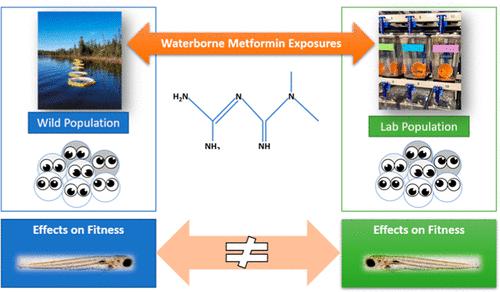当前位置:
X-MOL 学术
›
Environ. Sci. Technol.
›
论文详情
Our official English website, www.x-mol.net, welcomes your feedback! (Note: you will need to create a separate account there.)
Comparative Effects of Embryonic Metformin Exposure on Wild and Laboratory-Spawned Fathead Minnow (Pimephales promelas) Populations
Environmental Science & Technology ( IF 11.4 ) Pub Date : 2022-06-24 , DOI: 10.1021/acs.est.2c01079 Kristin M Nielsen 1 , Lily DeCamp 1 , Mona Birgisson 1 , Vince P Palace 2, 3 , Karen A Kidd 4 , Joanne L Parrott 5 , Mark E McMaster 5 , Mehran Alaee 5 , Nicholas Blandford 3 , Erin J Ussery 5
Environmental Science & Technology ( IF 11.4 ) Pub Date : 2022-06-24 , DOI: 10.1021/acs.est.2c01079 Kristin M Nielsen 1 , Lily DeCamp 1 , Mona Birgisson 1 , Vince P Palace 2, 3 , Karen A Kidd 4 , Joanne L Parrott 5 , Mark E McMaster 5 , Mehran Alaee 5 , Nicholas Blandford 3 , Erin J Ussery 5
Affiliation

|
Metformin is routinely detected in aquatic ecosystems because of its widespread use as a treatment for Type 2 diabetes. Laboratory studies have shown that exposure to environmentally relevant concentrations of metformin can alter metabolic pathways and impact the growth of early life stage (ELS) fish; however, it is unknown whether these effects occur in wild populations. Herein, we evaluate whether findings from laboratory studies are representative and describe the relative sensitivities of both populations. Duplicate exposures (0, 5, or 50 μg/L metformin) were conducted using wild- and lab-spawned fathead minnow (Pimephales promelas) embryos. Apart from the water source, exposure conditions remained constant. Wild embryos were exposed to previously dosed lake water to account for changes in bioavailability, while reconstituted freshwater was used for the laboratory study. Developmental metformin exposure differentially impacted the growth and morphology of both cohorts, with energy dyshomeostasis and visual effects indicated. The fitness of wild-spawned larvae was impacted to a greater extent relative to lab-spawned fish. Moreover, baseline data reveal important morphological differences between wild- and lab-spawned ELS fatheads that may diminish representativeness of lab studies. Findings also confirm the bioavailability of metformin in naturally occurring systems and suggest current exposure scenarios may be sufficient to negatively impact developing fish.
中文翻译:

胚胎二甲双胍暴露对野生和实验室繁殖的黑头鲦鱼(Pimephales promelas)种群的比较影响
二甲双胍在水生生态系统中经常被检测到,因为它广泛用于治疗 2 型糖尿病。实验室研究表明,暴露于环境相关浓度的二甲双胍可以改变代谢途径并影响生命早期(ELS)鱼类的生长;然而,尚不清楚这些影响是否发生在野生种群中。在这里,我们评估实验室研究的结果是否具有代表性,并描述了两个人群的相对敏感性。使用野生和实验室繁殖的黑头鲦鱼(Pimephales promelas) 胚胎。除了水源,暴露条件保持不变。将野生胚胎暴露于先前剂量的湖水中以解释生物利用度的变化,而重组淡水用于实验室研究。发育性二甲双胍暴露对两个队列的生长和形态有不同的影响,表明能量失调和视觉效应。相对于实验室产生的鱼,野生产生的幼虫的适应性受到更大程度的影响。此外,基线数据揭示了野生和实验室产生的 ELS 笨蛋之间的重要形态差异,这可能会降低实验室研究的代表性。研究结果还证实了二甲双胍在自然发生系统中的生物利用度,并表明当前的暴露情景可能足以对发育中的鱼类产生负面影响。
更新日期:2022-06-24
中文翻译:

胚胎二甲双胍暴露对野生和实验室繁殖的黑头鲦鱼(Pimephales promelas)种群的比较影响
二甲双胍在水生生态系统中经常被检测到,因为它广泛用于治疗 2 型糖尿病。实验室研究表明,暴露于环境相关浓度的二甲双胍可以改变代谢途径并影响生命早期(ELS)鱼类的生长;然而,尚不清楚这些影响是否发生在野生种群中。在这里,我们评估实验室研究的结果是否具有代表性,并描述了两个人群的相对敏感性。使用野生和实验室繁殖的黑头鲦鱼(Pimephales promelas) 胚胎。除了水源,暴露条件保持不变。将野生胚胎暴露于先前剂量的湖水中以解释生物利用度的变化,而重组淡水用于实验室研究。发育性二甲双胍暴露对两个队列的生长和形态有不同的影响,表明能量失调和视觉效应。相对于实验室产生的鱼,野生产生的幼虫的适应性受到更大程度的影响。此外,基线数据揭示了野生和实验室产生的 ELS 笨蛋之间的重要形态差异,这可能会降低实验室研究的代表性。研究结果还证实了二甲双胍在自然发生系统中的生物利用度,并表明当前的暴露情景可能足以对发育中的鱼类产生负面影响。


























 京公网安备 11010802027423号
京公网安备 11010802027423号